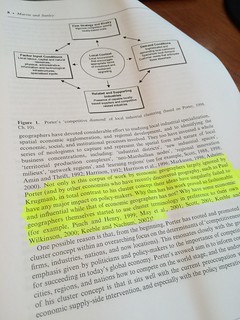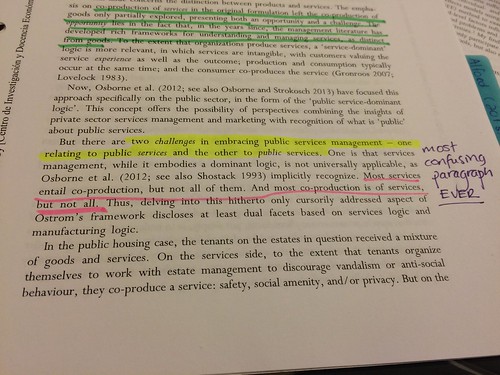One of the skills that needs to be in undergraduate and graduate students’ portfolios (and even post-PhD folks) is the ability to read, analyze, synthesize and then produce summaries of the research work we do. Highlighting is one of the ways in which I help myself learn the material I read, and I do it by hand rather than on the screen (many PDF-handling tools have highlighting features, but I prefer the actual physical thing). This week, I was trying to help my undergraduate students learn how to summarize journal articles and book chapters for their literature reviews and how to write reflective memos (most of my students are in 3rd and 4th year, so they are already in the process of writing the honors thesis/capstone paper). I figured I would post how I highlight (my own method) and perhaps some of them might find it useful for their own studying. I find it useful for my own research!
Some of my students ask why I use pink, yellow, green and blue highlighter. I use yellow for fundamental ideas. Green for second level.
— Dr Raul Pacheco-Vega (@raulpacheco) October 4, 2015
Trust me when I say that this is a topic that is often searched for on the internet (look at the results of this Google search!). But I find that most of this knowledge seems to be passed on by oral tradition (from professor to student “this is how I did my studying” or from parent, sibling or friend to child, sibling or friend). In fact, much of what I do now is a refined version of what my own PhD advisor, or professors, or even colleagues did, coupled with my own obsessive tendencies to organize everything.
 Well, here’s a version of how I read, highlight and summarize my own thinking (give or take). First, I skim the article. I read the abstract, the introduction and the conclusion. I search for the main ideas that the author purports to present in the paper. Then, as I read the article, I bring 3-4 different types of highlighters: thick yellow for main ideas, then 3 slim ones: pink, blue and green. I use “erasable highlighters” so that I can erase when I have made a mistake. I use the thick yellow highlighter to note the most important ideas in a paragraph. Given that we’re taught to open paragraphs with a sentence that summarizes the main idea of the entire paragraph, often I highlight that one. But sometimes, as I note on this example, the key idea that I want to highlight in the paragraph or that I find valuable doesn’t align with the author’s idea of what the main concept is. Still, I go with what I feel is the most relevant one.
Well, here’s a version of how I read, highlight and summarize my own thinking (give or take). First, I skim the article. I read the abstract, the introduction and the conclusion. I search for the main ideas that the author purports to present in the paper. Then, as I read the article, I bring 3-4 different types of highlighters: thick yellow for main ideas, then 3 slim ones: pink, blue and green. I use “erasable highlighters” so that I can erase when I have made a mistake. I use the thick yellow highlighter to note the most important ideas in a paragraph. Given that we’re taught to open paragraphs with a sentence that summarizes the main idea of the entire paragraph, often I highlight that one. But sometimes, as I note on this example, the key idea that I want to highlight in the paragraph or that I find valuable doesn’t align with the author’s idea of what the main concept is. Still, I go with what I feel is the most relevant one.
 Then I often find that some neat and interesting ideas flow from the previous ones, but aren’t central. These are what I call “second level” or “third level” ideas. Most often, what I do is that I use green highlighter to find the “second level” ideas, and then pink for the “follow-up” or third-level ideas. I often use blue highlighters to underline interesting ideas that could be worth checking out, but that if I skip when I teach (or when I write an article), it won’t be damaging to the central argument. As you can see in the example on the left, there was a sentence written by the author that called for my attention, but that isn’t central to the main argument that the author is positing (I wrote “OH SNAP” because it is a complaint that in my view is petty and shouldn’t have a place in an academic journal article, but it’s relevant nonetheless).
Then I often find that some neat and interesting ideas flow from the previous ones, but aren’t central. These are what I call “second level” or “third level” ideas. Most often, what I do is that I use green highlighter to find the “second level” ideas, and then pink for the “follow-up” or third-level ideas. I often use blue highlighters to underline interesting ideas that could be worth checking out, but that if I skip when I teach (or when I write an article), it won’t be damaging to the central argument. As you can see in the example on the left, there was a sentence written by the author that called for my attention, but that isn’t central to the main argument that the author is positing (I wrote “OH SNAP” because it is a complaint that in my view is petty and shouldn’t have a place in an academic journal article, but it’s relevant nonetheless).
Something else that many people have noticed when I highlight is that not only do I highlight, but I also use colored pens to write on the margins of the journal article. Mostly, these color codes are consistent with traditional views (e.g. red for VERY IMPORTANT STUFF, black for main ideas, blue for “interesting, though not fundamental”).
Something I’ve learned is that even though my own color-coding scheme will evolve, the main strategy of engaging with the material, reading and writing on the margins actually helps me with my own thinking. I’m definitely not the only academic who does this! (see below). Hopefully sharing my method will help my own students and someone else too!
@milaficent @raulpacheco i have sharpies, post it flags, and highlighters all keyed to one another and particular meanings. 🙂
— Aimée Morrison (@digiwonk) October 5, 2015


0 Responses
Stay in touch with the conversation, subscribe to the RSS feed for comments on this post.